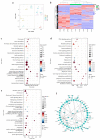Genome-wide detection of RNA editing events during the hair follicles cycle of Tianzhu white yak
- PMID: 36316632
- PMCID: PMC9624038
- DOI: 10.1186/s12864-022-08951-5
Genome-wide detection of RNA editing events during the hair follicles cycle of Tianzhu white yak
Abstract
Background: The hair coat is available for the yak to live in the harsh environment of the plateau. Besides, improving the hair production of yak is necessary for its textile industry development. Hair grows from hair follicles (HFs). The HFs undergo periodic growth after birth and are regulated by the complex gene regulatory network. However, the molecular mechanism of HFs regeneration in the Tianzhu white yak remains unclear. RNA editing is a post-transcriptional mechanism that regulates gene expression and produces new transcripts. Hence, we investigated the influence of the A-to-I RNA editing events on the HFs cycle of the Tianzhu white yak.
Results: We finally identified 54,707 adenosine-to-inosine (A-to-I) RNA editing sites (RESs) from RNA sequencing data of the HFs cycle in the Tianzhu white yak. Annotation results showed RESs caused missense amino acid changes in 7 known genes. And 202 A-to-I editing sites altered 23 target genes of 140 microRNAs. A total of 1,722 differential RESs were identified during the HFs cycle of Tianzhu white yak. GO and KEGG enrichment analysis revealed several signaling pathways and GO terms involved skin development, hair growth, and HFs cycle. Such as genes with differential RNA editing levels were significantly enriched in the peroxisome, metabolic pathways, Notch signaling pathway, and PPAR signaling pathway. Besides, the editing sites in HFs development-related genes FAS, APCDD1, WWOX, MPZL3, RUNX1, KANK2, DCN, DSC2, LEPR, HEPHL1, and PTK2B were suggested as the potential RESs involving HFs development.
Conclusion: This study investigated the global A-to-I RNA editing events during the HFs cycle of yak skin tissue and expanded the knowledge of A-to-I RNA editing on the HFs cycle. Furthermore, this study revealed that RNA editing-influenced genes may regulate the HFs cycle by participating in the HFs development-related pathways. The findings might provide new insight into the regulation of RNA editing in hair growth.
Keywords: Differential RNA editing sites; Hair follicles cycle; RNA editing; Tianzhu white yak.
© 2022. The Author(s).
Conflict of interest statement
The authors declare that they have no competing interests.
Figures



Similar articles
-
Integrative analysis of Iso-Seq and RNA-seq data reveals transcriptome complexity and differential isoform in skin tissues of different hair length Yak.BMC Genomics. 2024 May 21;25(1):498. doi: 10.1186/s12864-024-10345-8. BMC Genomics. 2024. PMID: 38773419 Free PMC article.
-
Genome-wide detection and sequence conservation analysis of long non-coding RNA during hair follicle cycle of yak.BMC Genomics. 2020 Oct 1;21(1):681. doi: 10.1186/s12864-020-07082-z. BMC Genomics. 2020. PMID: 32998696 Free PMC article.
-
The seasonal development dynamics of the yak hair cycle transcriptome.BMC Genomics. 2020 May 11;21(1):355. doi: 10.1186/s12864-020-6725-7. BMC Genomics. 2020. PMID: 32393236 Free PMC article.
-
The regulatory mechanism of microRNAs in skin and hair follicle development.Yi Chuan. 2014 Jul;36(7):655-60. doi: 10.3724/SP.J.1005.2014.0655. Yi Chuan. 2014. PMID: 25076029 Review.
-
Life of the B10 Mouse: A View from the Hair Follicles and Tissue Stem Cells.Cells Tissues Organs. 2024;213(3):213-222. doi: 10.1159/000533779. Epub 2023 Sep 13. Cells Tissues Organs. 2024. PMID: 37703854 Review.
Cited by
-
Proteomics Reveals the Role of PLIN2 in Regulating the Secondary Hair Follicle Cycle in Cashmere Goats.Int J Mol Sci. 2025 Mar 18;26(6):2710. doi: 10.3390/ijms26062710. Int J Mol Sci. 2025. PMID: 40141352 Free PMC article.
-
Dissecting genomes of multiple yak populations: unveiling ancestry and high-altitude adaptation through whole-genome resequencing analysis.BMC Genomics. 2025 Mar 3;26(1):214. doi: 10.1186/s12864-025-11387-2. BMC Genomics. 2025. PMID: 40033180 Free PMC article.
-
A-to-I RNA editing of CYP18A1 mediates transgenerational wing dimorphism in aphids.Elife. 2025 Apr 3;13:RP96540. doi: 10.7554/eLife.96540. Elife. 2025. PMID: 40178071 Free PMC article.
References
-
- Favarato ES, Conceicao LG. Hair cycle in dogs with different hair types in a tropical region of Brazil. Vet Dermatol. 2008;19:15–20. - PubMed
MeSH terms
Grants and funding
LinkOut - more resources
Full Text Sources
Research Materials
Miscellaneous

